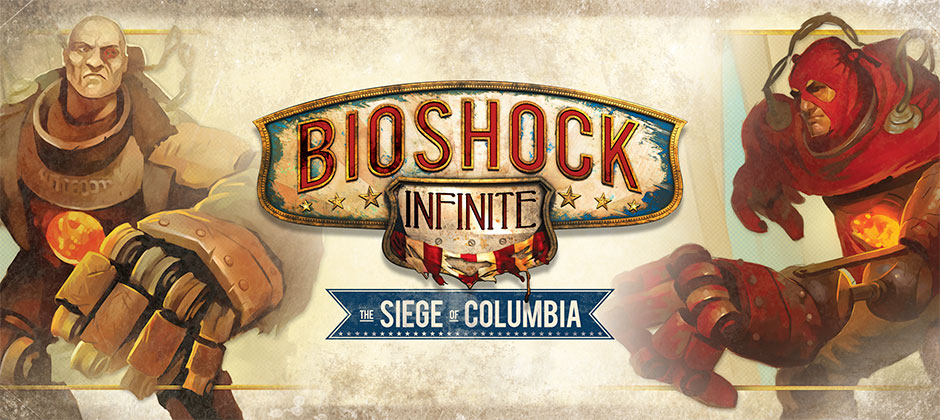
Take up arms to defend Mother Columbia!
Armed only with a Barnstormer RPG, a Paddywacker hand cannon and some inspiring rhetoric, The Esoteric Order of Gamers managed to round up the creative trio behind Bioshock Infinite: The Siege of Columbia: Colby Dauch, head of Plaid Hat Games, Isaac Vega, designer of BI:SoC and City of Remnants, and Peter Wocken, Plaid Hat’s graphic designer. Once they were tied up and subjected to several hours of instructional propaganda, they soon saw the wisdom of answering a few friendly questions about the making of Bioshock Infinite: The Siege of Columbia, each lending their fascinating insights into the process with an enthusiasm that bordered on the emotional. Don’t worry, they were eventually set free to once again take their places as productive citizens of Columbia after the ‘interview’ was over!
EOG: Have you played the video game? Are you interested in video games in general?
Colby Dauch: Yes we played BioShock and BioShock Infinite and are big fans of video games in general.
Isaac Vega: Yes I did get to play BioShock, great fun! I am a huge fan of video games. Some of my favorites in addition to BioShock are Final Fantasy, Skyrim, Fallout, and Borderlands.
Peter Wocken: I just picked up my copy of this Sunday and proceeded to play it until 5:30am. I didn’t quite finish it but I was loving on the visuals as well as the story and game play. Video games are a blast to play but I haven’t had much time to play them lately, other than micro gaming sessions on my iPhone.
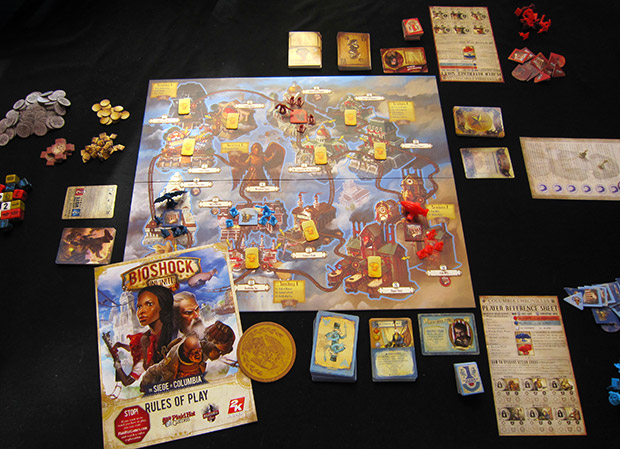
EOG: I think I can safely assume that the theme came first when you designed BioShock Infinite: The Siege of Columbia. Tell us about the challenge of having to design a game to an existing theme.
Colby Dauch: You have to iterate. You aren’t approaching it from I have an idea for a game, you are approaching from I need an idea for a game. So you potentially have to make several games before landing on a good one that works in that theme and is a fun game.
Isaac Vega: Like Colby said, there was a lot of experimenting when it comes to designing a game that is tied to license. You want to provide players with a unique experience but also want to give them an experience that is tied to the world that they are used to. Trying to find the right balance was the hardest part of the project.
Peter Wocken: It was not challenging to tell Colby “Heck yeah, sign me up!” when he first mentioned the project.
I enjoy games where the theme stands out as the star
EOG: Tell us a more about the design process.
Colby Dauch: I mentioned the challenges, the fun part about a license though is you get to borrow from a world that fans already have background information on and have seen visuals and know about the lore of that world. It makes telling emergent board game stores more vivid when you have a great license like this.
Peter Wocken: When I start working on a project, I like to start with my sketchbook and jot down notes as well as do some thumbnail sketches on what a card might look like. After I get a few examples that I like I’ll make them a bit larger and sketch out a rough sample of the card(s). I’ll snap a photo with my phone and email them to Colby so he can check them over, although sometimes I’ll just start laying out a quick sample in Illustrator.
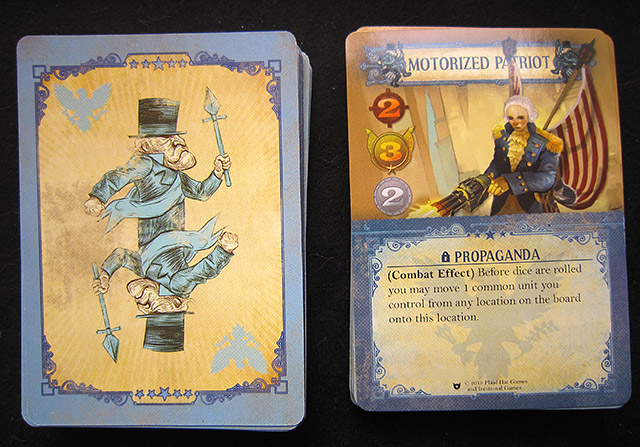
EOG: Tell us about the visual design of the game. How much art was supplied by Irrational and how much had to be developed? What challenges were there in bringing the visual themes of the video game to the boardgame?
Colby Dauch: Irrational supplied us with some art and helped direct the art and graphics of the game, but most of the visuals were made from scratch for this product. We felt that original art would be more exciting for the uber fan that knows the game and the art surrounding the game well.
Peter Wocken: PHG got the go-ahead to make the board game before the video game was finished, and as with any design projects, it’s not the final visual until it goes to press. Since the video game was still being produced I only had the Irrational Games website and a few trailers/gameplay videos that I found from different conventions. I essentially took screen caps of everything and started building my graphics from there. Based on what I saw I had a general feel for what the visuals should look like. It was just a matter of creating the elements that made up the visuals and get feedback from Colby and/or Irrational.
For example, I knew that we were going to be having money in the game. On one of the videos I saw a little coin shape as Booker was picking up or spending money, so I knew it would be a coin for the token. I designed a coin where one side had an eagle and the other was the Liberty Bell. It was based on the image of George Washington holding the bell while the banner under him read “It is our hold duty to guard against the foreign hordes.” I designed a nice golden coin that would make the Founders proud. Eventually, we get a file from Irrational of the actual Silver Eagles that are used in the game… so I updated the file and InDesign magically made it disappear.
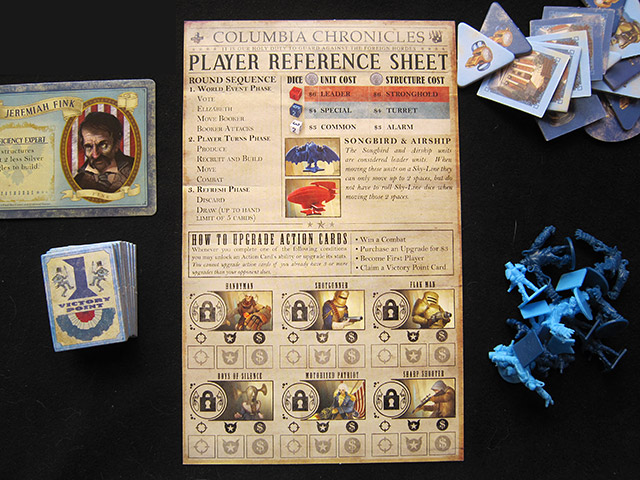
EOG: What kind of games do you enjoy? If so, any favorites and why? Were any a particular influence on the development of BIoshock Infinite: The Siege of Columbia?
Colby Dauch: I enjoy games where the theme stands out as the star.
Isaac Vega: Theme is also a big draw for me. I love me my mechanics, but I believe a good theme will always keep you coming back. Twilight Imperium was one of my biggest influences. I adore that epic game and it is too bad that I don’t get to play it more often because of its length.
Peter Wocken: Games with theme. I love to be entertained and the act of getting together with people to play games is fun, analog, and tactile.
EOG: Getting the licence for this high profile video game was quite a coup for Plaid Hat Games. How did that come about?
Colby Dauch: Irrational Games approached us and asked us if we’d like to do a board game for BioShock. We of course said yes. They are big board game fans over there, so they knew that they wanted a board game, rather than the usual reverse where a board game company will try to go out and get a license.
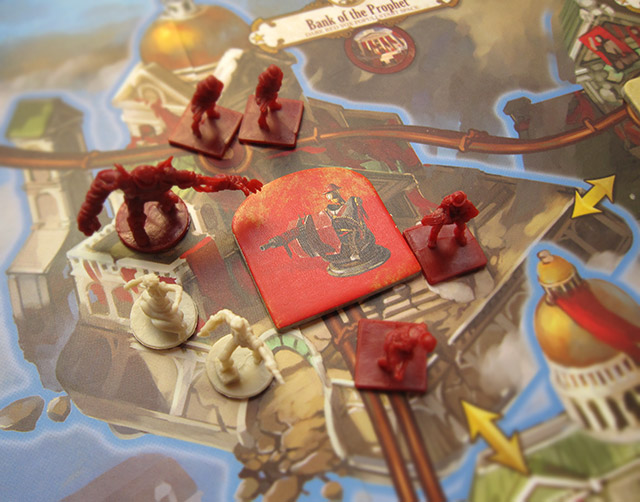
EOG: Any new mechanics/innovations that you’re particularly proud of in this game? Why?
Isaac Vega: I am personally very proud of the upgrade mechanic. As far as I know it has never been done before and is something I would love to explore adding in future games.
EOG: Some of the game concepts recall your last game City of Remnants—a bidding element, card play in combat, the random intervention of a non-player force to shake things up. What do you think sets BIoshock Infinite: The Siege of Columbia apart from that game?
We really wanted to write a love letter to BioShock fans with this game and feel like we did it justice
Isaac Vega: BioShock really feels like an all-out war. In City of Remnants there are many different ways to play, your enemies will shift from round to round, and you could even play peacefully if you choose to. BioShock really does a great job of representing the Vox Populi and Founders’ struggle to control Columbia. BioShock also has a much larger focus on hand management, making the decision of how to focus your actions in BioShock [something that] really sets the games apart. I love them both, and they both have some of my signatures, but once you get into the games you’ll notice that they are very different.
EOG: What do you think is special about this game and why should people get it?
Isaac Vega: For anyone looking to revisit the world of Columbia from a different perspective this game is a must have. We really wanted to write a love letter to BioShock fans with this game and feel like we did it justice. But to those board game enthusiasts out there who have never played any of the BioShock video games (though you should they are awesome) there is plenty of game for you as well. It is a solid 2 or 4 player game with lots to offer gamers of any level, and has plenty there to keep you playing over and over again.
Peter Wocken: It oozes theme and holds to the theme quite well.
EOG: Any plans for the future you can tease readers with? What’s next for Isaac Vega and/or Plaid Hat Games after BIoshock Infinite: The Siege of Columbia?
Isaac Vega: I have a few things coming down the pipeline at Plaid Hat. The next game that you will see from me, and co-designer Jon Gilmour, is called Survivor Chronicles: Dead of Winter. In Survivor Chronicles players will take on the role of a group of people in a survivor situation. The game deals with the interplay between those people and the psychology of a survival situation.
EOG: Thanks very much Colby, Isaac and Peter. The city of Columbia appreciates your cooperation!
If you want to read another, far more in-depth interview with Colby Dauch of Plaid Hat Games, I can’t do better than recommend you head on over to the excellent Shut Up & Sit Down website and check out their recent interview.